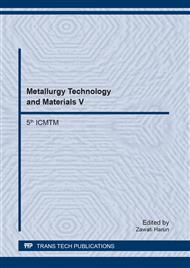[1]
N. Balagopal, K.G.K. Warrier, A.D. Damodaran, K.S. Krishnan, Colloidal processing of sol-sprayed ceramic particulate composites, J. Eur. Cera. Soc. 12 (1993) 449-453.
DOI: 10.1016/0955-2219(93)90078-6
Google Scholar
[2]
J. Fang, A. M. Thompson, M. P. Harmer, H. M. Chan, Effect of Yttrium and Lanthanum on the Final‐Stage Sintering Behavior of Ultrahigh‐Purity Alumina, J. Am. Ceram. Soc. 80 (1997) 2005-(2012).
DOI: 10.1111/j.1151-2916.1997.tb03084.x
Google Scholar
[3]
A. Krell, P. Blank, H. Ma, T. Hutzler, M. Nebelung, Processing of High‐Density Submicrometer Al2O3 for New Applications, J. Am. Ceram. Soc. 86 (2003) 546-53.
DOI: 10.1111/j.1151-2916.2003.tb03339.x
Google Scholar
[4]
C. Scott, M. Kaliszewski, C. Greskovich, L. Levinson, Conversion of Polycrystalline Al2O3 into Single‐Crystal Sapphire by Abnormal Grain Growth, J. Am. Ceram. Soc. 85 (2002) 1275-1280.
DOI: 10.1111/j.1151-2916.2002.tb00257.x
Google Scholar
[5]
S.K.C. Pillai, B. Baron, M. J. Pomeroy, S. Hampshire, Effect of oxide dopants on densification, microstructure and mechanical properties of alumina-silicon carbide nanocomposite ceramics prepared by pressureless sintering, J. Eur. Ceram. Soc. 24 (2004).
DOI: 10.1016/j.jeurceramsoc.2003.10.024
Google Scholar
[6]
D.A. Rani, Y. Yoshizawa, K. Hirao, Y. Yamauchi, Effect of Rare‐Earth Dopants on Mechanical Properties of Alumina, J. Am. Ceram. Soc. 87 (2004) 289-292.
DOI: 10.1111/j.1551-2916.2004.00289.x
Google Scholar
[7]
G. C. Wei, A. Hecker, D.A. Goodman, Translucent polycrystalline alumina with improved resistance to sodium attack, J. Am. Ceram. Soc. 84 (2001) 2853-2862.
DOI: 10.1111/j.1151-2916.2001.tb01105.x
Google Scholar
[8]
R. Apetz, M.P. Bruggen, Transparent Alumina: A Light‐Scattering Model, J. Am. Ceram. Soc. 86 (2003) 480-486.
DOI: 10.1111/j.1151-2916.2003.tb03325.x
Google Scholar
[9]
A.M. Arias, M.F. Garcia, L.N. Salamanca, R.X. Valenzuela, J.C. Conesa, J. Soria, Structural and Redox Properties of Ceria in Alumina-Supported Ceria Catalyst Supports, J. Phys. Chem. B, 104 (2000) 4038-4046.
DOI: 10.1021/jp992796y
Google Scholar
[10]
L. Dong, Y. Hu, S.T. Jin, J. Wang, W. Ding, Y. Chen, Dispersion Behavior of Copper Oxide on the Mixed CeO2+γ-Al2O3 Support, Chem. Mater. 13 (2001) 4227-4232.
DOI: 10.1021/cm0008462
Google Scholar
[11]
S. Bosew, Y. Wu, Synthesis of Al2O3–CeO2 Mixed Oxide Nano-Powders, J. Am. Ceram. Soc. 88 (2005) 1999-(2002).
Google Scholar
[12]
R. Pournajaf, S.A. Hassanzadeh-Tabrizi, M. Ghashan, Effect of surfactants on the synthesis of Al2O3–CeO2 nanocomposite using a reverse microemulsion method, Ceram. Int. 40 (2014) 4933-4937.
DOI: 10.1016/j.ceramint.2013.10.086
Google Scholar
[13]
V.V. Srdić, B. Mojić, M. Nikolić, S. Ognjanović, Recent progress on synthesis of ceramics core/shell nanostructures, Process. Appl. Ceram. 7 (2013) 45-62.
Google Scholar
[14]
M. Wiśniewska, S. Chibowski, T. Urban, Effect of the type of polymer functional groups on the structure of its film formed on the alumina surface-Suspension stability, React. Funct. Polym. 72 (2012) 791-798.
DOI: 10.1016/j.reactfunctpolym.2012.08.005
Google Scholar
[15]
B. Chanteau, J. Fresnais, J.F. Berret, Electrosteric enhanced stability of functional sub-10 nm cerium and iron oxide particles in cell culture medium, Langmuir, 25 (2009) 9064-9070.
DOI: 10.1021/la900833v
Google Scholar
[16]
A. Sehgal, Y. Lalatonne, J.F. Berret, M. Morvan, Precipitation-redispersion of cerium oxide nanoparticles with poly (acrylic acid): Toward stable dispersions, Langmuir 21 (2005) 9359-9364.
DOI: 10.1021/la0513757
Google Scholar
[17]
L Liu, S. Z Luo, B Wang, Z Guo, Investigation of small molecular weight poly (acrylic acid) adsorption on γ-alumina, Appl. Surf. Sci. 345 (2015) 116-121.
DOI: 10.1016/j.apsusc.2015.03.145
Google Scholar
[18]
M. Alifanti, B. Baps, N. Blangenois, J. Naud, P. Grange, B. Delmon, Characterization of CeO2-ZrO2 mixed oxides. Comparison of the citrate and sol-gel preparation methods, Chem. Mater. 15 (2003) 395-403.
DOI: 10.1021/cm021274j
Google Scholar


